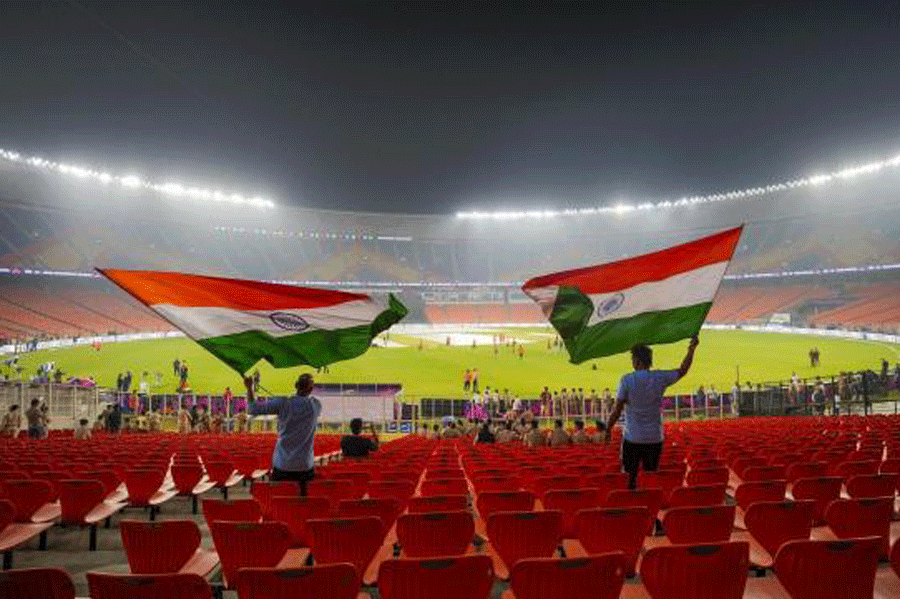There’s an iconic picture of Muhammad Ali standing over Sonny Liston after the latter had gone down from the “phantom punch” during their world title fight in 1965. The result, a controversial one after Ali won with a first-round knockout, is a different story, but the image strikes a stunning symbol of the champion berating the vanquished after a duel.
One’s not sure what Liston felt while he lay at the feet of Ali, but it must have been something similar to what billions of Indians experienced decades later in a different ring, the ‘Bullring’. On March 23, 2003, at the Wanderers in Johannesburg, India fell face-first in the World Cup final against Australia, the 125-run thrashing bringing the Indians — cricket fans and beyond — crashing to the ground as their balloons of sky-high expectations got rudely deflated. It’s not too difficult to imagine Australia as Ali because they were that good on way to winning their third world title.
Twenty years later, it’s another World Cup final and once again the Australians are in India’s way. India’s stupendous run to the final this time without losing a single game has given wings to hope, the nation which is obsessed with cricket is already slobbering for glory. It’s a Sunday and all of India have invited themselves to a grand cricket party, a party so elephantine that even the big fat IPL wedding of cricket and glamour will be of no match.
But can the Aussie threat be ignored so nonchalantly? Can’t they play party-poopers? Fact is, they can. They haven’t been five-time champions by the flip of coins, they are known to bring out their best on the biggest of stages, they have a mental make-up that intimidates even the best on their bestest days.
So what can Rohit Sharma do so that he doesn’t end up like a Sourav Ganguly on Sunday in Ahmedabad?

Australia players rejoice after winning the 2003 World Cup final. Getty Images
For starters, Rohit, if he wins the toss, must make a wise decision. It can be a tricky call. Sourav, infamously, had erred in opting to field first in Johannesburg even though the conditions begged otherwise. The conditions in Ahmedabad don’t pose a big challenge, but a final is a final. Conviction in decisions should have legs of wisdom or else there’s every chance of an embarrassing fall.
Much easier for Rohit would be to lose the toss. Why? First, because that spares him the burden of decision-making. Second, he can then afford to think, ‘what difference does it make for my marauding army whether we bat first or second?’ He has the numbers to back that up. In 10 matches so far, India have chased in the first five and won, and in the next five, they have defended and still been unbeatable. That’s an envious position to be in.
Once the toss is out of the way, Rohit must ensure that his men start strong. Remember how a young Zaheer Khan had messed up the first over in 2003? The left-arm pacer had bowled a 10-ball first over, spraying it all over with wides and no-balls. You don’t do that against Australia. Give them an inch, and they will manufacture a mile. Rohit must see to it that a Mohammed Siraj doesn’t overstep in exuberance, handing the Aussies the tempo to run the show.
A good start with the ball is also mandatory given the uncanny similarity that the current Aussie top-order has with their 2003 line-up. Matthew Hayden and Adam Gilchrist, two merciless left-handers, had murdered the Indian bowlers putting up a 100-plus opening stand. Australia never looked back. This time too, two lefties, David Warner and Travis Head, able successors to Hayden and Gilchrist in terms of brutality with the bat, sit at the top of the Aussie batting order. Rohit’s India must nip the danger in the bud.
Equally important would be the start India get with the bat. They didn’t have a good one in 2003, losing Sachin Tendulkar in the first over. Rohit carries that responsibility this time. He has been the force at the top that has given wind to India’s sails. He needs to do that one more time, and also guide the young Shubman Gill past the traps that the Aussies lay. Losing too many wickets too early is a recipe for disaster in a final.
Most of the other things can take care of themselves if the above points are taken care of. If the first few steps are taken right, India have the depth in bowling and batting that can sink the Aussies.
But it’s not just the 2003 debacle that can impart lessons to Rohit. India’s quarter-final win over the men from Down Under in the 2011 World Cup is also a case study that must be read. Coincidentally, that too was played in Ahmedabad. It was a match where the Indian bowlers and batters, despite being under pressure, never lost sight of the target. They absorbed every drop of pressure and, led by a flourishing Yuvraj Singh, completed a masterful chase.
The Motera is bigger now, it seats over a lakh of spectators. Like the Coliseum, it looks over its gladiators, baying for blood. Failure isn’t welcome, success triggers unearthly cheers, and the pressure of it all can squeeze a player to a pulp. India must stay guarded. Or else, Bees Saal Baad, Rohit would be left humming, “Kahin deep jale kahin dil...”










